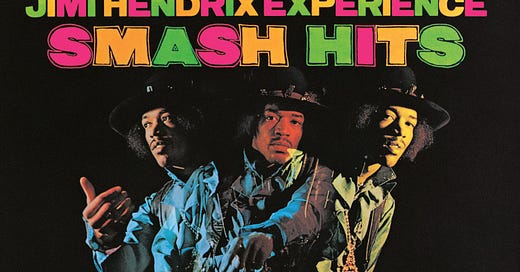While Jimi Hendrix is often hailed as “rock’s greatest guitarist,” the music he most closely identified with was the blues. After all, this had been the soundtrack of his youth, the music he heard his paternal grandmother sing and his father play on their record player. “Jimi lived on blues around the house,” Al Hendrix remembered. “I had a lot of records by B.B. King and Louis Jordan and some of the downhome guys like Muddy Waters. Jimi was real excited by B.B. King and Chuck Berry, and he was a fan of Albert King too. He liked all them blues guitarists. He’d try to copy what he’d heard, and he’d make up stuff too.”
Jimi’s account of his musical roots aligned with his father’s: “I was largely influenced by blues when I first started,” he reported in Rolling Stone. “When I first started playing guitar, it was way up in the Northwest, in Seattle, Washington, and they don’t have too many real blues singers up there. The first guitarist I was aware of was Muddy Waters. I heard one of his old records when I was a little boy, and it scared me to death. Wow! What was that all about? It was great.”
After playing in local groups, teenaged Jimi enlisted in the U.S. Army’s 101st Airborne. While military life didn’t suit him, he found a lifelong friend there in Billy Cox, who played bass alongside him during their journeyman days. Years later, Billy rejoined Jimi for his appearances at Woodstock, with the Band of Gypsys, and during his final tours. “You can call Jimi Hendrix whatever you like,” Cox told me, “but he was a blues master. That’s what he was. A hell of a bluesmen. You run that type of playing through a Fuzz Face and a loud amp, and what do you have? You have something that somebody may interpret as something else, but it’s really nothing but blues. Since he was so hot on guitar, people said, ‘Wait a minute, we’ve never heard blues played like this,’ but that’s what it was. His style also reflected his youth and social awareness, but just about everything Jimi and I recorded was blues. Everything was right from the soil, right from the depth of mankind. Blues was part of our being.
“Jimi’s playing was always rooted in the blues. Those were the only songs we jammed on at the very, very beginning, because musically we were limited. At that particular time, he was basically a rhythm and blues player. That was his roots. His favorite players were Muddy Waters, Howlin’ Wolf, Lightnin’ Hopkins, Albert King, B.B. King, and especially Slim Harpo. Those blues masters were Jimi’s early influences, and a lot of the songs that we initially started playing were by those guys. That was point A. Then we graduated into the Top-40 R&B and then into a lot of pop numbers. He was also aware of Robert Johnson and Lead Belly and Elmo [Elmore] James, as he spoke of him. Blues was a part of our being.” Before Jimi went off on his own as a freelance musician, he and Billy roomed together in Nashville and backed blues and R&B artists such as Nappy Brown, Carla Thomas, and Ironing Board Sam.
By mid-1966, Hendrix had had enough of playing the chitlin circuit behind Little Richard, Curtis Knight, Jackie Wilson, the Isley Brothers, and other touring R&B acts. These gigs required him to stay in the background and adhere to carefully arranged parts. Pay was minimal, recording opportunities sparse, and life on the road was hard, particularly in the Jim Crow South. Onstage, Hendrix was required to conform to the image of touring R&B musicians, with their slick hair, matching suits, and choreographed stage moves. Desperately poor and running out of opportunities, he was living hand-to-mouth in New York City when a chance encounter with Chas Chandler, bassist for the Animals, led to an invitation to leave it all behind. Chandler promised Jimi that if he accompanied him to England, he could help him organize a band, score him a record deal, and – at Jimi’s specific request – introduce him to Eric Clapton. Hendrix jumped at the opportunity.
After Jimi’s arrival in late September 1966, word quickly spread about the amazing newcomer who spent his evenings jamming in small clubs. In addition to his brilliant guitar playing, Jimi’s singing style appealed to London’s blues aficionados. “Jimi was singing like Muddy Waters,” observed John McLaughlin. “Jimi had that thing, had the sound. It was almost part talking, part chanting. And he had the timbre, that sound that Muddy’s voice had. So by the time he hit, people were just like, ‘Wow, Jimi, beautiful!’ Jimi had found his creative common. All the things by chance that were around him were absolutely ideal in that moment.”
Keep reading with a 7-day free trial
Subscribe to Talking Guitar ★ Jas Obrecht's Music Magazine to keep reading this post and get 7 days of free access to the full post archives.



